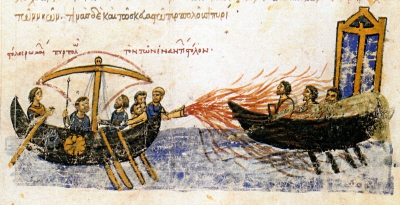The Battle of the Yarmuk (also spelled Yarmouk) was a major battle between the army of the Byzantine Empire and the Muslim forces of the Rashidun Caliphate. The battle consisted of a series of engagements that lasted for six days in August 636, near the Yarmouk River, along what are now the borders of SyriaJordan and Syria-Israel, southeast of the Sea of Galilee. The result of the battle was a complete Muslim victory that ended Byzantine rule in Syria. The Battle of the Yarmuk is regarded as one of the most decisive battles in military history, and it marked the first great wave of early Muslim conquests after the death of the Islamic prophet Muhammad, heralding the rapid advance of Islam into the then-Christian Levant.
To check the Arab advance and to recover lost territory, Emperor Heraclius had sent a massive expedition to the Levant in May 636. As the Byzantine army approached, the Arabs tactically withdrew from Syria and regrouped all their forces at the Yarmuk plains close to the Arabian Peninsula, where they were reinforced, and defeated the numerically superior Byzantine army. The battle is widely regarded to be Khalid ibn al-Walid's greatest military victory and cemented his reputation as one of the greatest tacticians and cavalry commanders in history.
The Arab–Byzantine wars were a series of wars between a number of Muslim Arab dynasties and the Byzantine Empire between the 7th and 12th centuries AD. Conflict started during the initial Muslim conquests, under the expansionist Rashidun and Umayyad caliphs, in the 7th century and continued by their successors until the mid-12th century.
The emergence of Muslim Arabs from Arabia in the 630s resulted in the rapid loss of Byzantium's southern provinces (Syria and Egypt) to the Arab Caliphate. Over the next fifty years, under the Umayyad caliphs, the Arabs would launch repeated raids into still-Byzantine Asia Minor, twice besiege the Byzantine capital of Constantinople, and conquer the Byzantine Exarchate of Africa. The situation did not stabilize until after the failure of the Second Arab Siege of Constantinople in 718, when the Taurus Mountains on the eastern rim of Asia Minor became established as the mutual, heavily fortified and largely depopulated frontier. Under the Abbasid Empire, relations became more normal, with embassies exchanged and even periods of truce, but conflict remained the norm, with almost annual raids and counter-raids, sponsored either by the Abbasid government or by local rulers, well into the 10th century.
During the first centuries, the Byzantines were usually on the defensive, and avoided open field battles, preferring to retreat to their fortified strongholds. Only after 740 did they begin to launch their raids in an attempt to combat the Arabs and take the lands they had lost, but still the Abbasid Empire was able to retaliate with often massive and destructive invasions of Asia Minor. With the decline and fragmentation of the Abbasid state after 861 and the concurrent strengthening of the Byzantine Empire under the Macedonian dynasty, the tide gradually turned. Over a period of fifty years from ca. 920 to 976, the Byzantines finally broke through the Muslim defences and restored their control over northern Syria and Greater Armenia. The last century of the Arab–Byzantine wars was dominated by frontier conflicts with the Fatimids in Syria, but the border remained stable until the appearance of a new people, the Seljuk Turks, after 1060.
The Arabs also took to the sea, and from the 650s on, the entire Mediterranean Sea became a battleground, with raids and counter-raids being launched against islands and the coastal settlements. Arab raids reached a peak in the 9th and early 10th centuries, after the conquests of Crete, Malta and Sicily, with their fleets reaching the coasts of France and Dalmatia and even the suburbs of Constantinople.

 English
English  español
español  français
français  português
português  русский
русский  العربية
العربية  简体中文
简体中文 
